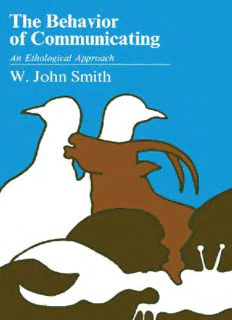
The Behavior of Communicating: An Ethological Approach PDF
Preview The Behavior of Communicating: An Ethological Approach
The Behavior of Communicating The Behavior HARVARD UNIVERSITY PRESS CAMBRIDGE, MASSACHUSETTS AND LONDON, ENGLAND of Communicating ~_~.tr An Ethological Approach w. JOHN SMITH Copyright © 1977 by the President and Fellows of Harvard College All rights reserved Printed in the United States ofAmerica Third printing, 1980 Library of Congress Cataloging in Publication Data Smith, William John. The behavior of communicating. Includes bibliographical references and index. 1. Animal communication. I. Title. QL776.S64 591.5'9 76-43021 ISBN 0-674-06465-8 (cloth) ISBN 0-674-06466-6 (paper) To Ernst Mayr Acknowledgments Fourteen months spentin research at the Smithsonian Tropical Research Institute during 1970 and 1971 gave me an opportunity to think about the conceptual structure required for a comprehensive approach to the ethological study of communication, and to consider exploring this in a book. While the concern grew from the directions my research has taken since 1959, work on the book did not begin until the autumn of 1971. Theimpetus thenwas an advanced undergraduate course in animal com munication that I startedto teach at the University of Pennsylvania. This teaching has since provided a yearly need to review the diverse explora tions under way on the behavior of communicating, to investigate the relationsbetweendifferent approaches, and to devise aframework within which the aims of research on different aspects of the topic could be integrated. Many people have helped me learn to study behavior. I am particu larlygrateful to ErnstMayr and Martin Moynihan, who first encouraged andguidedmyevolutionaryandethological interests; to my parents, who earlier encouraged a love of nature and study; and to those who taught and advised me at all stages, especiallyBillBaldwin, PeterMillman, Bert Nesbitt, George Wallace, Ed Wilson, Don Griffin, Robert MacArthur, and Paul Rozin. Special thanks are offered to those who have read and commented on all or large parts of drafts of the manuscript: David Ainley, Malte Andersson, Colin Beer, Hugh Dingle, Erving Goffman, Ilan Golani, Don Griffin, Robert Hinde, Michi Ishida, Adam Kendon, Amy Kramer, Ernst Mayr, Ed Miller, Martin Moynihan, Michael Simp son, and Ed Wilson. Similar gratitude is due those who advised on more limited sections: Norm Adler, Mike Baker, Marc Bekoff, Penny Bern stein, Dick Estes, Frank Gill, Henry and Lila Gleitman, Jack Hailman, Gail Haslett, BillLabov, PeterMarler, Gene Morton, Roger Payne, Stan viii ACKNOWLEDGMENTS Rand, Bob Ricklefs, Burt Rosner, Steve Rothstein, Paul Rozin, Neal Smith, Sharon Smith, Sue Smith, Chuck Snowdon, Margie Sonntag, Bob Storer, William A. Wilson, Jf., Gail Zivin, and Naida Zucker. Figure 1.2 was devised and drawn by Robin Yeaton; the other figures werepreparedbyLaurieSandandJohn andBetteWollsey, withfinancial assistance from the Institute of Neurological Sciences. The authors and publisherswho havepermittedfigures tobereproduced are appreciatively thanked. Institutions have been important throughout in providing colleagues, resources, and bases for my work. My main appointments are to the University of Pennsylvania, where I am a member of the Departments of Biology and Psychology and interact frequently with colleagues and students in other departments, institutes, graduate and professional schools; and to the Smithsonian Tropical Research Institute, where I have additional colleagues and do much of my field work. I also have formal affiliations with the Philadelphia Zoological Society and the Academy ofNatural Sciences of Philadelphia, and began the research as agraduate andthena postdoctoral studentatthe BiologicalLaboratories and the Museum of Comparative Zoology of Harvard University. Many other institutions with which I have no formal ties have been extremely helpful over the years and have been acknowledged in my published re ports of research. Part of the time spent in writing was aided by the Na tional Science Foundation, which has been the major source of support for my research. The Wenner-Gren Foundation for Anthropological Research and Tom Sebeok deserve special thanks for bringing me to gether on several occasions with behavioral scientists from diverse dis ciplines and thereby greatly expanding my perspective. I could not have managed the task of preparing this book without the continualunderstanding and support of Sue and Ben, who havebeen ex ceedinglypatient. Contents 1 Introduction 1 2 TheDiversity ofDisplays 23 3 Analysis of a Display Repertoire 46 4 Messages: TheKinds ofInformationMade Available by Displays 69 5 Widespread BehavioralSelectionMessages 87 6 FurtherMessages: Behavioral and Nonbehavioral 127 7 The Origin ofWidespreadMessages 169 8 Differing Approaches to the Analysis ofDisplayBehavior 192 9 ContextualSources of Information 224 10 Meanings and Functions 261 11 Origins and Differentiation ofDisplayBehavior 312 12 Effects ofEvolution ontheForms ofDisplays and Accoutrements 343 13 TheConceptofFormalizedBehavior 389 14 Formalized Interactions 426 15 A Prologue to the Studyof Communicating 458 References 469 Index 514
Description: